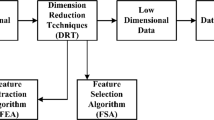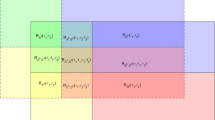Abstract
A novel method of signal fusion, namely multi-dimensional unified signal (MDUS) fusion algorithm, is proposed based on dimensionality expansion of the cognitive radio (CR). The paper focuses on the issue of under-utilized and overcrowded spectrum bands in CR, through multi-component signal fusion. The proposed MDUS fusion algorithm can meet the basic requirement of signal fusion, that is, transmitting multi-component signal in one signal simultaneously, while basic signal elements, such as amplitude and bit rate, are not constrained by the fusion. The one-dimensional imaginary domain of the signal can be expanded to two, three or higher-dimensional imaginary space by exploiting the property of logical recursion. The original data flows can be extended to three, four or higher dimensions according to functional demands. Thus, the complementary aims of mutually independent orthogonal space and multivariate signal transmission without interference, are achieved by fusing multiple uni-dimensional signals into a multi-dimensional signal. Hence, based on the electromagnetic environment, a more flexible solution can be provided for spectrum occupancy of CR users. Specifically, the number of Orthogonal Frequency Division Multiplexing (OFDM) sub-bands and MDUS dimension can be dynamically converted, based on the MDUS–OFDM structure. The proposed approach can be utilized to provide more accurate estimation and prediction of transmission quality for CR Networks. Simulation results show the MDUS offers both BER and dimensionality advantage compared to the OFDM. Additionally, single-dimensional spectrum patterns can be expanded to alterable multi-dimensional spectrum patterns owing to the flexibility of MDUS–OFDM structure.














Similar content being viewed by others
References
A. Basit, I.M. Qureshi, W. Khan, A.N. Malik, Range—angle-dependent beamforming for cognitive antenna array radar with frequency diversity. Cognit. Comput. 8(2), 113 (2016)
S. Bokharaiee, H.H. Nguyen, E. Shwedyk, A decoding-based fusion rule for cooperative spectrum sensing with nonorthogonal transmission of local decisions. Eurasip J. Wirel. Commun. Netw. 2013(1), 110 (2013)
D. Davalle, R. Cassettari, S. Saponara, L. Fanucci, L. Cucchi, F. Bigongiari, W. Errico, Design, implementation and testing of a flexible fully-digital transponder for low-earth orbit satellite communications. J. Circuits Syst. Comput. 23(10), 13 (2014)
G. Ding, J. Wang, Q. Wu, Y.D. Yao, F. Song, T.A. Tsiftsis, Cellular-base-station-assisted device-to-device communications in TV white space. IEEE J. Sel. Areas Commun. 34(1), 107–121 (2015)
G. Ding, J. Wang, Q. Wu, L. Zhang, Robust spectrum sensing with crowd sensors. Commun. IEEE Trans. 62(9), 3129–3143 (2014)
R. Etkin, A. Parekh, D. Tse, Spectrum sharing for unlicensed bands. IEEE J. Sel. Areas Commun. 25(3), 517528 (2007)
X. He, D.N. Aloi, J. Li, Probabilistic multi-sensor fusion based indoor positioning system on a mobile device. Sensors 15(12), 31464–31481 (2015)
Y. Hei, W. Li, M. Li, Z. Qiu, W. Fu, Optimization of multiuser MIMO cooperative spectrum sensing in cognitive radio networks. Cognit. Comput. 7(3), 359–368 (2015)
R. Heideklang, P. Shokouhi, Multi-sensor image fusion at signal level for improved near-surface crack detection. Ndt E Int. 71, 16–22 (2015)
N. Kausar, A. Majid, S.G. Javed, A novel ensemble approach using individual features for multi-focus image fusion. Comput. Electr. Eng. 54, 393–405 (2016)
H. Li, X. Chen, G. Jing, Y. Wang, Y. Cao, F. Li, X. Zhang, X. Han, An indoor continuous positioning algorithm on the move by fusing sensors and Wi-Fi on smartphones. Sensors 15(12), 31244–31267 (2015)
I. Maherin, Q. Liang, Multistep information fusion for target detection using UWB radar sensor network. IEEE Sens. J. 15(10), 5927–5937 (2015)
I. Mitola Joseph, Gerald Q. Maguire, Cognitive radio: making software radios more personal. IEEE Pers. Commun. J. 6(4), 13–18 (1999)
E.C.Y. Peh, Y.C. Liang, Y.L. Guan, Y. Zeng, Cooperative spectrum sensing in Cognitive Radio networks with weighted decision fusion schemes. IEEE Trans. Wirel. Commun. 9(12), 3838–3847 (2010)
S. Poria, E. Cambria, A. Hussain, G.B. Huang, Towards an intelligent framework for multimodal affective data analysis. Neural Netw.Off. J. Int. Neural Netw. Soc. 63, 104–116 (2015)
H. Sadeghi, P. Azmi, Performance analysis of linear cooperative cyclostationary spectrum sensing over nakagami-\(m\) fading channels. Veh. Technol. IEEE Trans. 63(9), 4748–4756 (2014)
A.E. Shafie, T. Khattab, A.S. Salem, Relay-assisted primary and secondary transmissions in Cognitive Radio networks. IEEE Access 4, 6386–6400 (2016)
Y. Sun, B.L. Mark, Y. Ephraim, Collaborative spectrum sensing via online estimation of Hidden Bivariate Markov models. IEEE Trans. Wirel. Commun. 15(8), 5430–5439 (2016)
C.C. Took, D.P. Mandic, The quaternion LMS algorithm for adaptive filtering of hypercomplex processes. IEEE Trans. Signal Process. 57(4), 1316–1327 (2009)
X. Yan, H. Qin, J. Li, H. Zhou, J.G. Zong, Infrared and visible image fusion with spectral graph wavelet transform. J. Opt. Soc. Am. A Opt. Image Sci. Vis. 32(9), 1643–1652 (2015)
H. Yin, Z. Liu, B. Fang, Y. Li, A novel image fusion approach based on compressive sensing. Opt. Commun. 354, 299–313 (2015)
T. Yucek, H. Arslan, A survey of spectrum sensing algorithms for cognitive radio applications. IEEE Commun. Surv. Tutor. 11(1), 116–130 (2009)
Z. Zhang, Z. Zhang, S. Liu, Cross domain boosting for information fusion in heterogeneous sensor-cyber sources. Signal Process. 126, 180–186 (2015)
S. Zhao, L. Zhang, Y. Zhou, N. Liu, Signal fusion-based algorithms to discriminate between radar targets and deception jamming in distributed multiple radar architectures. IEEE Sens. J. 15(11), 6697–6706 (2015)
Y. Zhuang, H. Lan, Y. Li, N. ElSheimy, PDR/INS/WIFI integration based on handheld devices for indoor pedestrian navigation. Micromachines 6(6), 793–812 (2015)
Acknowledgements
The authors are grateful to the anonymous reviewers for their insightful comments and suggestions, which helped to improve the quality of this paper.
Author information
Authors and Affiliations
Corresponding author
Additional information
This work was supported by the National Natural Science Foundation of China under Grant Nos. 61301261 and 61601091, and the Fundamental Research Funds for the Central Universities of China under Grant No. ZYGX2015J121. Professor A. Hussain is supported by the UK Engineering and Physical Sciences Research Council (EPSRC) grant no. EP/M026981/1.
Rights and permissions
About this article
Cite this article
Zhang, T., Xu, L., Yang, E. et al. A Novel Method of Signal Fusion Based on Dimension Expansion. Circuits Syst Signal Process 37, 4295–4318 (2018). https://doi.org/10.1007/s00034-018-0760-5
Received:
Revised:
Accepted:
Published:
Issue Date:
DOI: https://doi.org/10.1007/s00034-018-0760-5




